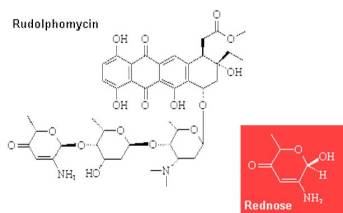Today I just want a say a huge molecular Merry Christmas to you all. This will be the last post now until 2nd January, when I’ll be back to bring molecular joy to your dreary January.
In searching for an appropriate way to celebrate Christmas at a Molecular Circus, I came across what is clearly the coolest idea on the planet, ever. T-shirts that spell out names, words and greetings in the amino acid code, the language of protein structure. If anyone is ever looking for a gift for me, ever again, I will never stop thinking this is brilliant (and you can get ones with your name spelt out, I am in the process of buying myself one of these. Coolest geek ever).

Those two molecules spell Happy Holidays in amino acid code. Just so cool.
Image credit.
I’ve mentioned before that proteins are formed from chains of amino acids, like beads on a string. There are actually just 20 amino acids that are used to create proteins in your cells, and each of them has been assigned a single letter code, in order to make protein sequences shorter and smaller for use in data files back in the days when computers had considerably more limited memory.
All amino acids have the same basic structure, containing an amine group (NH2) and a carboxylic acid group (COOH). This is the basic building block. Each one then also has a variable group, a side chain sticking out, known as the R group. This is what changes between one amino acid and the next, and it’s these groups that change the chemical nature of the different amino acids, they’re what gives amino acids their distinct personalities; determining whether they like or hate water, how likely they are to be friendly and interact with other amino acids, and whether they’re positive or negative types.
For example, the amino acid alanine has a very simple R-group; it’s just one hydrogen atom. Alanine (A) is therefore an amino acid with a very small side chain, it’s a very neutral and accommodating amino acid, it doesn’t take up much room, it’s unobtrusive and helpful, doesn’t get in the way. Unless, of course there’s water around, it’s not accommodating then, in fact it hates water. On the other hand, the amino acid lysine (K), is a lot chunkier, not only is it chemically BIGGER than alanine, it also has a positive charge, so while it doesn’t mind water, it actively repels the two negatively charged amino acids, which can cause problems if they accidentally end up nearby. Each of the 20 amino acids has slightly different properties.
A protein is simply a long chain of these amino acids, attached together by peptide bonds. The chain itself is known as the backbone of the protein, and the R-groups stick out as side chains. Although there are only 20 amino acids, and 26 letters of the alphabet, it is still, joyously, the case that I can wish you all a MERRY CHRISTMAS in amino acid code, which is definitely the geekiest and probably the most awesome way I have ever wished anyone a Merry Christmas.

A Molecular Merry Christmas!
The top molecule spells Merry (the amino acids are methionine, glutamic acid, arginine, arginine and tyrosine), the bottom molecule spells Christmas (the amino acids are cysteine, histidine, arginine, isoleucine, serine, threonine, methionine, alanine and serine)
Image credit.
Finally, as a last Christmas gift to you all, I have found a molecule named Rudolphomycin. Disappointingly, it wasn’t actually named after the reindeer, but instead after the character Rudolfo, from the Puccini opera La Boheme. However, when rudolphomycin breaks down, a small sugar molecule is formed, which has been named rednose. Sometimes you just have to LOVE science.

Rudolphomycin and rednose. The most festive of all molecules!
Image credit.
Merry Christmas Everyone!







And a merry molecular Christmas to you too KL! x
…or a molecular merry Christmas!
Hahahaa, rednose 🙂
A molecular merry christmas to you. Looking forward to meeting maybe. (Ok so now I sound like Carly Rae oops).
Enjoy the holidays, the friends, the family, the preparations.
Ahh, the O in Happy Holidays is pyrrolysine! 22nd amino acid. =) This post was great, happy holidays to all!
have a great Xmas Katielase,
Chris, Dorset, England
(half way through MSc Medicinal Chemistry)
Merry Christmas! xx